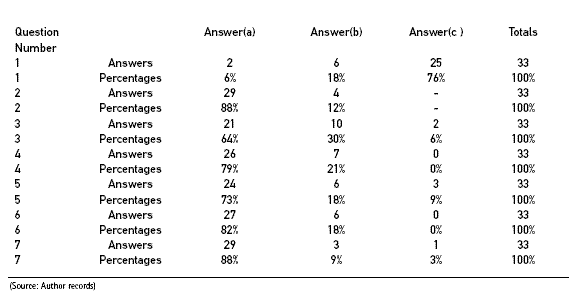Serviços Personalizados
Journal
Artigo
Indicadores
-
 Citado por SciELO
Citado por SciELO -
 Acessos
Acessos
Links relacionados
-
 Citado por Google
Citado por Google -
 Similares em
SciELO
Similares em
SciELO -
 Similares em Google
Similares em Google
Compartilhar
Educación y Educadores
versão impressa ISSN 0123-1294versão On-line ISSN 2027-5358
educ.educ. v.10 n.1 Chia jan./jun. 2007
An account on teaching an english content course in finances
Enseñanza del inglés basada en contenidos: experiencia de un curso de finanzas
Ensayo
Jorge Restrepo G.1
1Bsc. Industrial Economics- MBA-Associate Professor - Universidad de La Sabana, Escuela Internacional de Ciencias Económicas y Administrativas. jorge.restrepo@unisabana.edu.co
Abstract
This paper presents a brief description of English Content Based Instruction (CBI) as a process in which the student gains mastery of the language (procedural knowledge) and mastery of the subject learned (declarative knowledge) along with the characteristics of the integration of the teaching process. Also, the author describes his experiences in planning and teaching a course in Financial Analysis using the techniques of CBI and student-centered learning in addition to the tools and procedures used in performing this task. Furthermore the experiences of other universities in giving CBI courses are analyzed in the light of this experience. The result of a survey about the perception of the course among a representative sample of the students is presented and discussed. Finally the paper presents an analysis of a survey which suggests the importance of the CBI approach in teaching finance in English
Key words: English content instruction, competences, student-centered instruction, study guides.
Resumen
En este artículo se presenta una breve descripción de la Enseñanza de Inglés Basada en Contenidos (CBI), como un proceso en el cual el alumno adquiere dominio de la lengua (conocimiento procedimental), así como dominio de la asignatura estudiada (conocimiento declarativo), mediante un proceso de enseñanza que integra lengua y contenido. El autor describe sus experiencias en la planeación y enseñanza de un curso de análisis financiero utilizando las técnicas de CBI y de aprendizaje centrado en el estudiante, además de las herramientas y procedimientos más tradi cionales. También se analizan las experiencias de otras universidades que imparten CBI, a la luz de nuestra propia experiencia. Se presenta y discute el resultado de una encuesta sobre la percepción del curso por parte de una mues tra representativa de estudiantes. Finalmente, se presenta el análisis de una encuesta, que sugiere la importancia del enfoque CBI en la enseñanza de finanzas en inglés
Palabras clave: Enseñanza de inglés basada en contenidos, enseñanza centrada en el estudiante, guías de estudio.
Objectives
The objective of this paper is to report the experiences obtained by the author during an English Content Based Instruction (CBI) course in financial analysis, and to provide information about how the students perceive the fact of learning Finance in English. It has been part of the policy of the University and the International School of Economic and Administrative Sciences to offer courses in English based on a student-centered model. The results of the survey on the strategies for the course are analyzed in order to observe if these strategies had already been used and assess the extent and success of their utilization.
English Content Courses
"Content Based Instruction (CBI) methodology is not new in education. The concept of "Content" as a process of cognition as disclosed by Sticht1, is related to the fact that all human intellectual activities such as thinking, communicating, problem solving and learning require both processes and content (knowledge): this suggests that merely raising people's cognitive abilities to higher levels by simply improving competencies such as "reading", "writing" or "critical thinking" is nearly futile to the learning process. In order to perform these tasks at higher thinking skills levels, it is essential to employ content knowledge in the learning process.
From the perspective mentioned above we can say that the learning of mainstream subjects in a language other than the native one, such as English, focuses upon the substance or meaning of the subject that is being taught, such as the theoretical basis and practical applications of the tools for performing adequate financial analysis.
This paper focuses essentially on the process of acquiring several types of knowledge by means of an English Content course in a finance subject. It is my intention to explain two of the most important types of knowledge and how they are acquired by students who use the different strategies disclosed below. First, the meaning of two fundamental aspects of knowledge: declarative knowledge and procedural knowledge is explained; and in the rest of the paper I expect to clearly demonstrate how the CBI approach to the course contributed to a successful processing of these types of knowledge.
Knowledge is, in the first place, "a fluid mix of framed experience, values, contextual information and expert insight that provides a framework for evaluating and incorporating new experiences and information"2. It's clear that the content of the course in financial analysis incorporated these elements in the form of fluid explanation and understanding of logical bases, specific and organized procedures to train a critical and analytical mind to examine the financial statements of a company and use them to formulate diagnostics and suggest different strategies that essentially aim at increasing the market value of the enterprises.
Declarative knowledge: It comes from the idea that you declare something, such as "this is a balance sheet". This type of knowledge implies that you identify something and recognize aspects like objects, terms, definitions, facts and ideas. Declarative knowledge consists of descriptions of facts and occurrences, methods and procedures. In other words, the underlying assumption of this concept is that the student acquires a set of facts that are organized to permit reasoning. Financial analysis is a properly organized science that clearly allows the application of declarative knowledge in the terms already explained with the purpose to identify and describe information related to the financial performance of the companies, and most importantly, to exert the reason to obtain conclusions and formulate proposals.
Procedural knowledge is the knowledge related to the action, or "doing", of a process. The concept of procedural knowledge is tied to the concept of performing a process based in declarative knowledge previously explained. To describe this type of knowledge is to establish the necessary steps or tasks to perform something. Procedural knowledge is also related to the competence or capacity of doing something. I can not think of more accurate examples of procedural knowledge in this context other than the tasks performed by the students in the course of a systematic analysis or financial statements in order to determine parameters of the company such as liquidity, situation of debt or profitability. This knowledge is closely related to the workshops assigned in the course and its pertinence is adequately measured and validated in this paper.
So, in a narrower sense, CBI courses according to Ward and Karet3 seek to increase the usage proficiency of a foreign language (in this case, English) as the student takes a course in his/her academic discipline, such as finance. The strength of this method is that it produces both declarative knowledge (what a person knows), and procedural knowledge (what a person can do). Therefore, usage of language is maximized as the process of learning financial analysis is accomplished. The Content-Based Instruction approach produces both types of knowledge as the student gains mastery of the language (procedural knowledge) and mastery of the subject learned (declarative knowledge).
CBI as a pedagogic strategy for teaching finances:
CBI allows the integration of particular concepts, in this case, the procedures for analyzing financial statements and formulating diagnostics, while improving foreign language skills. The focus of a CBI lesson in Finance is the subject being taught, and foreign language acquisition occurs in the context. Therefore, foreign language learning is never divorced from the understanding and practice of an interesting subject, and content-based instruction provides a context for meaningful communication to occur. Second language acquisition is enhanced by teaching finances, because students learn language best when there is an emphasis on relevant and interesting topics, rather than on the language itself. People do not learn languages and subsequently use them, but rather learn languages by using them. Hence, Content-Based instruction in finances provides the bases for improving English skills because the subjects are presented in a motivating way, through practical exercises, which lead them to realize the importance of applying the topics being taught to real life situations. Moreover, the interaction of the students with their peers in order to solve financial problems allowed them to obtain more security to express ideas and concepts in written and oral workshops.
According to Jourdenais and Shaw4, and Grabe and Stoller among others, CBI is by no means a new concept in foreign language education. Since the 1960s a growing interest had been focused on teaching a specific language for specific tasks or educational purposes. Examples of this are Spanish for the medical profession, Japanese for business, English for all the activities dealing with aeronautical operations and air control. However, English Content Based Instruction is much broader in scope in that it seeks to gain complete language proficiency. In Canada the need for this approach stemmed from the importance given to develop high levels of proficiency in French since it is a second language for many Canadian students outside Quebec. Grabe and Stoller stressed that "content based instruction results in language learning, content learning, increased motivation and interest levels, and greater opportunities of employment (where language abilities are necessary)"5.
Furthermore, Jourdenais and Shaw6 exposed several characteristics of CBI that are, to some extent, similar to our experiences in teaching English content courses in finance at our University:
- Learners are exposed to native language while learning content courses in English.
- Content areas are relevant to academic and/or professional needs. This condition is particularly important in Finance, as will be specified below on this paper.
- Language is contextualized through relevant content areas and hence relevant to learner needs.
- Support is provided for learner's linguistic development by a Foreign Language Department through collaborative work with language specialists.
- Focus is placed on developing academic and/or professional language proficiency.
- Authentic and useful materials in English are used to present content matter: See the reference to the author's student guides in this paper.
- The use of these authentic materials lends itself to the integration of skills, to increase motivation, and to an increased cognitive and linguistic complexity which have been confirmed by the survey.
Background
At the beginning of the academic year of 2004, and on the initiative of the Foreign Languages Department, a special research group on CBI was convened with the intention of: "Developing and implementing strategies based on autonomous learning through student centered learning as a medium for instruction on delivering content at the University level by considering student centered approaches"7.
At this point, it is worth mentioning the work of McCombs and Whistler8 who note that student-centered teaching occurs when the topics studied are relevant to students' lives, needs and interests, and when the student is actively engaged in creating, understanding and connecting their own knowledge to the course. The teacher is better a guide in the learning process than a transmitter of knowledge. Furthermore, the students are encouraged to find their information using the material provided appropriately, and working with their peers in understanding cases and workshops. Essentially, these authors argue that "learners are treated as co-creators in the learning process, as individuals with ideas and issues that deserve attention and consideration".
The CBI research group, of which the author of this paper was an active member, met every week for two hours, and designed a research proposal that was finally discussed and approved by the University authorities9.
During the second semester of 2001, I was invited by the head of the "Área de Economía y Finanzas" to offer an English Content course in the subject of Financial Analysis beginning at the first semester of 2002. This particular assignment posed the following challenges:
1. To design the structure of a course that provides the students with the skills and competences in financial analysis, including all the topics belonging to this subject such as: financial ratio analysis, working capital structure of the firm, cash flow analysis, financial planning models and financial and operative leverages.
2. To develop the strategies necessary to give an English content course for Spanish speaking students with different degrees of proficiency in the English language.
3. Based on the teacher's experience, it is important to mention that at the beginning of the semester many students felt pessimistic about the outcome of the course given the heterogeneity of their language skills. Since English is a foreign language their abilities in reading, writing and speaking are not homogeneous; hence, many of them refrain from participating in the presence of more skilled students.
4. An important consideration had to be given to the fact that the topics in finance build one upon another successively, and an adequate continuity in English content learning must be present in all the finance courses in order to smoothly follow up abilities and competences obtained during previous semesters' work. Of course, it is easier to teach and learn in a native language, but it is also important to remember that "We are assured that second- language speakers of English will soon outnumber native language speakers in the world" as noted by O'Dowd10. This is a reality in the modern globalized world, which is important to address through several courses, as there will be more opportunities for English speaking business professionals around the world, particularly in the case of Colombia which is in the process of signing a Free Trade Agreement with the USA.
A complete program was designed well in advance with an appropriate bibliography in English, considering the student's language level. Furthermore, the teacher prepared class guides in English in order to enhance the learning process. These guides contained an adequate and easy to understand description of the course topics with problems and exercises to test the learning progress of the students. The course topics included:
- The objectives of financial function and the work of financial managers.
- The structure of financial statements
- Sources and uses of funds
- Financial ratio analyses- Du Pont analysis
- Financial planning
- Operational and financial leverages
In performing all these tasks, I received the effective support and collaboration of the Foreign Languages Department of the University. This help consisted mainly of assistance in the review of the study material and guides, monitoring of the class methods, advisory work on class strategies, and teaching procedures directed at improving the quality of the learning process.
The number of groups and students of financial analysis classes in English from the first semester of 2002 to the first semester of 2004 was as follows:
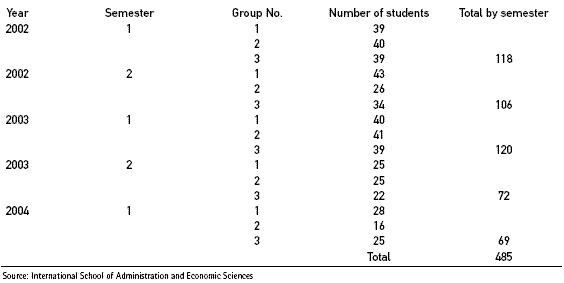
As we can see the group sizes varied from 23 to 43 students with an average of 32 students per class. The results of group work and student-centered techniques are tested and measured in the survey described later in this paper. Of course, the size of the course is important when considering activities in the teaching process, as in larger groups there is a lower attention span, making it more difficult for the teacher to focus on specific student needs.
In the course of this research we found useful help from the experiences obtained in CBI from other academic institutions around the world.
The Universitat Internacional de Catalunya of Barcelona, Spain11, supported its ESB efforts through an English for Specific Academic Purposes (ESP) curriculum in the undergraduate cycle. This curriculum involves not only designing and writing ad-hoc classroom and self-study materials (a subject that has been approached by the author through Financial Analysis Guides), but also training English teachers in aspects of disciplinary content areas, genres, and specialized language features.
1. Another very important contribution in the area of ECBI is the view of the Macquarie University of Sydney, Australia12, that makes use of scaffolded assignments given to the non-English speaking students that are progressively starting in first-year accounting teaching with communicative language teaching, using these assignments to check and activate key concepts in finance. This is followed up with"knowledge transforming" writing activities by giving the students increasingly difficult tasks both in terms of content and in terms of language. The researchers in this study concluded that these progressive writing assignments dramatically improved the ability of the students' ability to understand and express concepts and opinions in English.
2. The experiences of Belarus State University of Minsk13 summarize the competences and skills that must be acquired by the ECB students of Finances. Teaching Finances in English as a Foreign Language to students in order to fulfill the following:
- Competences to obtain success in business by being positive, thoughtful, a team player, interested, punctual, organized, prepared, polite, patient, and loyal.
- Special skills in telephoning and messaging including preparing and receiving communications, taking and leaving messages, conversation and preparing and practicing negotiations.
- Business correspondence principles, including a variety of business letters: enquiries, replies, orders, payments, polite complaints, fax and e- mail.
- The fundamentals for making different kinds of presentations, including problem-solving and successful participation in conferences.
- The abilities in preparing for job-seeking process including searching for job openings. Preparations of personal background and different types of résumés and going through an interview process.
The CBI process in Finance also involved this practical preparation of students by following a continuous process in techniques such as accounting, financial analysis, international business, project preparation and evaluation, banking, fiscal matters, economics, price formation, and social safety nets.
Based on the previous experiences, we can suggest that the English Content Research of the Foreign Languages Department must evaluate to what extent these principles have been applied to CBI courses at the University, according to the procedures being successfully applied by other academic institutions.
Experiences in giving content teaching classes
Keeping in mind that the process for teaching English Content courses is a major objective of the University, and a very important part of its Strategic Development Plan, our approach to this procedure was a positive one, pursuing the proper attitudes, adequate material organization and strategies, evaluation process, and continuous feed-back in order to take corrective actions when language problems arose. These problems occur when specific students' learning skills fall under average levels, and are reflected by their academic performance. In such cases, personalized help must be provided to the students by using the advisory procedures, like sheltered instruction, which involves the languages department support in specific areas, such as offering students with languages difficulties workshops which address written and oral competencies. The main strategies and instruments used in the course of Financial Analysis according to the principles provided by the Foreign Languages Department are:
1. Course Program: The students receive a course program that includes: General and Specific Objectives, a detailed class schedule for each date with topics, readings, and course assignments or workshops with delivery dates and percentage of grades; dates for Progress Reports (mid term exams) and Final Exam. Detailed requirements for preparing and presenting workshops, quizzes and tests in an adequate way are also highlighted in the program. The professor's availability for advisory sessions, attendance requirement to classes and punctuality, are also stressed. Finally, a detailed bibliography of all course topics is included.
2. Class work: Focus was geared towards the intensive use of English language, avoiding the use of Spanish, and also avoiding the use of direct translation, trying to make the students decipher the meaning of technical terms in English within the lesson context, instead
3. Workshops: This type of work covered all the topics of the course. The workshops were assigned on a weekly basis to the students, the reports were discussed in class and their evaluation was an important component of the student's final grade. The workshops are also designed to allow the students discuss specific finance problems and solve them through the collective use of distinct student competencies. The workshops consisted of problems and cases related to:
- Building financial statements
- Building and analyzing the statement of Sources and Uses of Funds
- Analyzing and reaching conclusions about the company's liquidity, debt, and profitability situations through the use of financial ratios.
- Analyzing the company's financial structure by using the Du-Pont analysis system.
- Formulating a complete financial planning model and building the pro-forma financial Statements: Balance Sheet, Income Statement, and Cash Flow, with finance requirements.
- Measuring the company's operating and financial leverages
4. Language: All lectures, tests and exams are given in English, with the provision of additional help from the instructor to overcome specific language difficulties.
5. Use of the Web: During the course, special priority was given to the use of the Internet as a means of obtaining information and special cases in Financial Statement Analysis. The students are required to search through the web for Financial Statements of companies belonging to different sectors, analyze them, and submit written reports in English with the results and conclusions of their research. This approach has also been a language strategy as students could access this information on their own, permitting them to spend as much time as needed to decipher the information.
6. Software: An extensive use of software tools such as Word and Excel was made, to properly prepare and present class work. These programs do not require advanced levels of language to display results, given their usage of tables and graphs.
7. Feed-back: All the workshops, quizzes, and exams were subject to a detailed feedback through the correction of mistakes, and explanation of the areas that have posed major comprehension problems. This feedback was developed as a routine part of all class sessions; there were no specific recordings of the sessions, but the survey on the course, presented in this paper, measured the general attitude and precise opinions of the students towards the procedures and strategies used.
Survey on English Content Teaching
As a way to test the student's feelings toward CBI in the Financial Analysis course, a special attitude survey was designed and given at the end of the first semester of 2004. Questions were carefully worded in order to assure that the answers provided an adequate evaluation of the methods applied during the semester. The evaluation of the English content course tries to assess the student's point of view of the validity of strategies and materials utilized. Furthermore, the advantages or disadvantages of taking these courses and the degree of the course contribution to competences that are expected to be obtained within this pedagogic process were assessed.
This survey was designed by the Foreign Language Department and applied to a sample of 33 students, which means the 47.8% of the 69 students that took the course during the second semester of 2004. The survey consists of seven statements requiring students to select the one that they felt was the most appropriate to their situation. The statements are:
1. The course is:
a. Lecture based
b. Based on class activities
c. Combination of a and b
This question is oriented towards the delivery of the course. It tests the extent of the studentcentered approach in teaching the course.
2. It is:
a. An advantage to have the course in English
b. A disadvantage to have the course in English
This question tests the student's general attitude towards an English content learning process.
3. Having the course in English:
a. Provides a broader access to material about the content
b. Provides a little more material than usual about the content
c. Does not provide any access to material
This question is oriented to testing the extent to which the students have or do not have access to English Content material in finance, and also their perception of the advantages of having the course in English.
4. (The student) has been exposed to:
a. At least four written works in English
b. Less than four written works in English
c. No works in English
This question tries to quantify the number of tasks in English given to the students during the course, in order to measure the level of exposure to advanced written production. It indicates the ability to undertake work in English that is comparable to that in the native language.
5. Having the course in English:
a. Provides more diversity of perspectives on the topics raised in the course
b. Provides a little diversity on perspectives on the subjects raised in the course.
c. Provides no perspectives
This question measures the student's perception of the importance of the course in providing a broader perspective to the subject matter.
6. Having the course in English:
a. Exposed me to the contents of the subject at a global level
b. Provides little exposure to the subject at a global level
c. Provides no exposure to the subject
This question tries to determine if the contents covered in the course are globally focused.
7. The course will:
a. Contribute to making me more competitive because it is in English
b. Slightly contribute making me more competitive
c. Will not contribute to making me more competitive
Finally, this last question determines if the students felt that they are more competent as a consequence of having taking a CBI course in Finance.
Survey quantification
The results of the survey are shown in the following table:
Graphs of the survey results:
Question No. 1: The course is:
a. Lecture based
b. Based on class activities
c. Combination of a and b
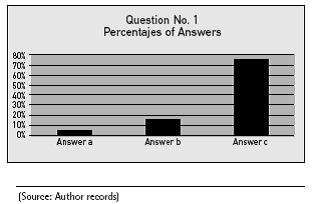
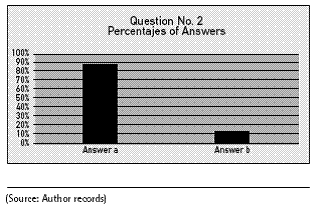
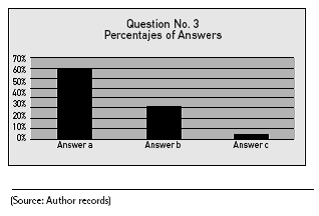
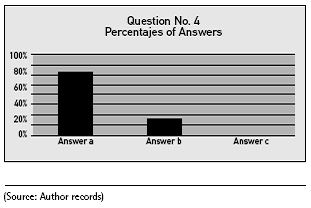

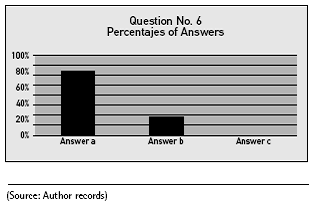
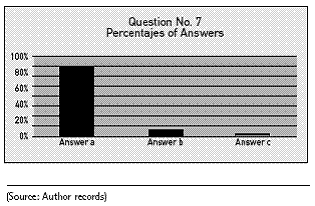
Summary and Conclusions:
1. Summary:
The course strategies were planned as disclosed in the program, along with the contents. The guides were produced and the strategies developed by the author, with the advice of the Foreign Languages Department, following the principles of student-centered teaching. These strategies were followed throughout the course of four semesters, covering a population of 485 students.
2. Students' overall assessment:
A total of 33 students took part in the Survey (47.8% of the participants).
- 76% stated that the course was based on a combination of class activities and lectures.
- 88% believed that it is an advantage to have the course in English.
- 64% stated that having the course in English provides a broader access to material related to the content.
- 79% declared that they had been exposed to at least four written works in English.
- 73% stated that having the course in English provides more diversity in perspectives on the topics raised during the course.
- 82% stated that the course exposed them to the contents on the subject at a global level.
- 88% believed that the course contributes to make them more competitive, because of the English proficiency.
3. Conclusion:
Summarizing the content on this report, we can say that the majority of the students were satisfied with the English Content experiences. Moreover, the survey also provided interesting insights into the significance and perception of the course for the students. Furthermore, the importance of language, and the utilization of language strategies which are largely student-centered were highly regarded.
Finally, I wish to state that teaching this CBI course in Finances has been a very motivating and enriching experience not only for me but for the Business Faculty and the University. Also, it represents the outcome of a process that must be an important part of our academic training. Undoubtedly, as in any form of teaching, the initiation process is not without mistakes and errors. However, I believe that embarking upon this experience, which considers the simultaneous teaching of content and language, is enlightening not only for teaching finance courses but all mainstream courses in English, as the strategies discussed in this paper are applicable to a broad array of subjects. The CBI approach has proven to be able to enhance the teaching of a mainstream subject, and I suggest that others should look into it as they consider teaching courses in English.
Future research in this area should consider involving more courses taught in English using the same strategies in order to further consolidate their efficacy. I felt that this experience required undergoing a change in the teaching paradigm as it involved the language teaching process, and that other instructors Could greatly benefit from the approach given its student-centered nature.
Finally, it is important to stress on the Jim Cummins' notion of Cognitive Academic Language Proficiency (CALP), that "students need to be learning content while they are developing CALP; there is not enough time to separate language and content learning particularly at the tertiary level; postponing content instruction while students develop more advanced (academic) language is not only impractical but also ignores student's needs, interests, and cognitive levels"14. So this is a task that requires absolute priority in University programs, and I think this paper can contribute to demonstrate so.
Bibliografía
1. Anderson, J.R. Cognitive psychology and his implications. (NY: W. H. Freeman,1993). [ Links ]
2. Cummins, Jim. The Role of primary language development in promoting educational success for language minoritystudents: A theoretical framework. (Los Angeles: California State University, Evaluation, Dissemination and Assessment Center, 1981). [ Links ]
3. Grabe, W. & Stoller, F. L. Content-Based Instruction. Research Foundations. (1997). [ Links ]
4. Jourdenais, Renée & Shaw, Peter A. Dimensions of Content-Based Instruction in Second language Education.(Monterey, California: Monterey Institute of International Studies, 2005). [ Links ]
5. O'Dowd, Elizabeth, PhD. Abstract: « World English and Bilingual Education: Legacy and Lessons for the NewMillennium.» (Vermont, USA: School of International Studies, Saint Michael College, 1999). [ Links ]
6. Snow, M.A. & Brinton, D.A., eds. The content-based classroom : Perspectives on integrating language and content.(White Plains, NY: Longman, 1998). [ Links ]
7. Stitch, Thomas. "The Theory Behind Content- Based Education." Focus on Basis Vol 1, Issue D. (Dec 97). [ Links ]
8. The Learner-Centered Classroom and School Strategies for Increasing Student Motivation and Achievement. (San Francisco: Josey Bass Publishers, 1997). [ Links ]
9. Universidad de La Sabana. Research Proposal on English Content Teaching, paper by the Foreign languages Department (2004). [ Links ]
10. Ward, Dana & Karet, Julia. "The Content - Based Approach," paper presented in The Asia World Wide Web Conference(Beijing August 23, 1966), and The Second Hong Kong Web Symposium. (Hong Kong, August 27-28). [ Links ]
Abstracts cited from the Internet (http://www.unimaas.nl/icl)
1. Martínez, Marial Francisca & Corcó, Joseph. Abstract: "Delivering Higher Education in a Non- English Speaking Country: A Spanish Experience for a Challenging Project." (Spain: Universitat Internacional de Catalunya of Barcelona, October 25/2004). [ Links ]
2. Jones, Alan. "Integrating Content With Language in First-Year Accounting: Perceptions of Scaffolded Writing Tasks." (Sydney, Australia: Macquaire University, October 24, 2004). [ Links ]
3. Slepovich, Viktor. "Content as Part of Teaching Business Communication in English." (Minsk, Belarus: Belarus State Economic University, October 24, 2004). [ Links ]
Films
An interview with a student presented during the author's speech on October the 27th in the course of the First Content Based Learning and Instruction Symposium in the Universidad de La Sabana, at 17:00 hours. [ Links ]
2 Davenport, T. and Prusak, L. Working Knowledge. Boston: Harvard Business School Press, 1998.
3 Dana Ward & Julia Karet. "The Content - Based Approach", paper presented in the Asia World Wide Web Conference (Beijing, August 23, 1966), and The Second Hong Kong Web Symposium (Hong Kong, August 27-28).
4 Renée Jourdenais & Peter A. Shaw. Dimensions of Content-Based Instruction in Second language Education (Monterey, California: Monterey Institute of International Studies, 2005).
5 Grabe & Stoller. Content-Based Instruction: A Shell for Language Teaching or a Framework for Strategic Language and Content Learning? (Salt Lake City: Annual meeting of Teachers of English to Speakers of Other Languages, March 2002).
6 Jourdenais and Shaw. Ibid..
7 Universidad de La Sabana, Research Proposal on English Content Teaching, paper by the Foreign languages Department (2004).
8 The Learner Centered Classroom and School Strategies for Increasing Student Motivation and Achievement (San Francisco: Josey Bass Publishers - 1997).
9 As a further evidence of the cooperation between the author and the Foreign Languages Department, this Symposium took place at the University on October 27th and 28th of 2006. This later day the author gave a speech in English about the English Content course experiences, and a filmed interview was conducted with a student who gave, also in English, a rendition of his experiences and opinions about the outcome of the course, was presented. This film is also apart of the back-up material for this article.
10 O'Dowd, Elizabeth, PhD, Abstract: « World English and Bilingual Education: Legacy and Lessons for the New Millennium» (Vermont, USA: School of International Studies, Saint Michael College, 1999).
11 Martínez, Marial Francisca & Corcó, Joseph. Abstract: "Delivering Higher Education in a Non- English Speaking Country: A Spanish Experience for a Challenging Project" (Spain: Universitat Internacional de Catalunya of Barcelona, October 25/2004.
12 Jones, Alan. "Integrating content with language in First-Year Accounting: Perceptions of Scaffolded Writing Tasks" (Sydney, Australia: Macquaire University, October 24, 2004).
13 Slepovich, Viktor. "Content as Part of Teaching Business Communication in English" (Minsk, Belarus: Belarus State Economic University, October 24, 2004).
14 Jim Cummins, The Role of primary language development in promoting educational success for language minority students: A theoretical framework, (Los Angeles: California State University, Evaluation, Dissemination and Assessment Center, 1981).
Fecha de recepción: 09-IV-2007Fecha de arbitraje: 19-IV-2007













